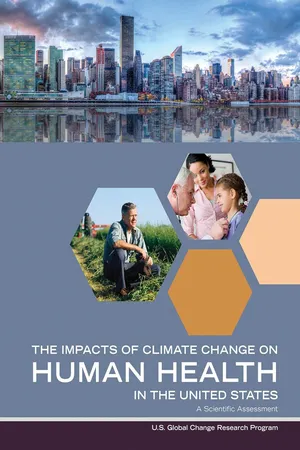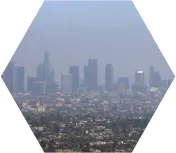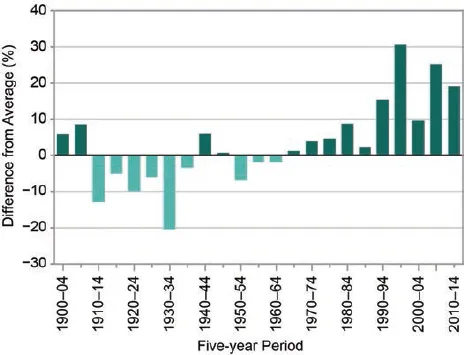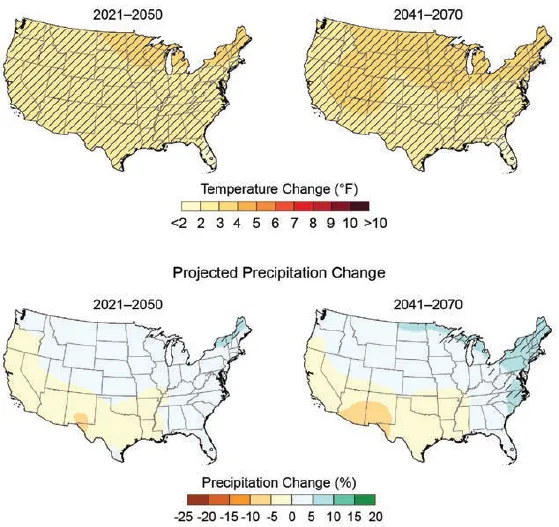
eBook - ePub
Impacts of Climate Change on Human Health in the United States
A Scientific Assessment
US Global Change Research Program
This is a test
Partager le livre
- 999 pages
- English
- ePUB (adapté aux mobiles)
- Disponible sur iOS et Android
eBook - ePub
Impacts of Climate Change on Human Health in the United States
A Scientific Assessment
US Global Change Research Program
Détails du livre
Aperçu du livre
Table des matières
Citations
À propos de ce livre
As global climate change proliferates, so too do the health risks associated with the changing world around us. Called for in the President's Climate Action Plan and put together by experts from eight different Federal agencies, The Impacts of Climate Change on Human Health: A Scientific Assessment is a comprehensive report on these evolving health risks, including:
- Temperature-related death and illness
- Air quality deterioration
- Impacts of extreme events on human health
- Vector-borne diseases
-
Climate impacts on water-related Illness -
Food safety, nutrition, and distribution -
Mental health and well-being -
This report summarizes scientific data in a concise and accessible fashion for the general public, providing executive summaries, key takeaways, and full-color diagrams and charts. Learn what health risks face you and your family as a result of global climate change and start preparing now with The Impacts of Climate Change on Human Health.
Foire aux questions
Comment puis-je résilier mon abonnement ?
Il vous suffit de vous rendre dans la section compte dans paramètres et de cliquer sur « Résilier l’abonnement ». C’est aussi simple que cela ! Une fois que vous aurez résilié votre abonnement, il restera actif pour le reste de la période pour laquelle vous avez payé. Découvrez-en plus ici.
Puis-je / comment puis-je télécharger des livres ?
Pour le moment, tous nos livres en format ePub adaptés aux mobiles peuvent être téléchargés via l’application. La plupart de nos PDF sont également disponibles en téléchargement et les autres seront téléchargeables très prochainement. Découvrez-en plus ici.
Quelle est la différence entre les formules tarifaires ?
Les deux abonnements vous donnent un accès complet à la bibliothèque et à toutes les fonctionnalités de Perlego. Les seules différences sont les tarifs ainsi que la période d’abonnement : avec l’abonnement annuel, vous économiserez environ 30 % par rapport à 12 mois d’abonnement mensuel.
Qu’est-ce que Perlego ?
Nous sommes un service d’abonnement à des ouvrages universitaires en ligne, où vous pouvez accéder à toute une bibliothèque pour un prix inférieur à celui d’un seul livre par mois. Avec plus d’un million de livres sur plus de 1 000 sujets, nous avons ce qu’il vous faut ! Découvrez-en plus ici.
Prenez-vous en charge la synthèse vocale ?
Recherchez le symbole Écouter sur votre prochain livre pour voir si vous pouvez l’écouter. L’outil Écouter lit le texte à haute voix pour vous, en surlignant le passage qui est en cours de lecture. Vous pouvez le mettre sur pause, l’accélérer ou le ralentir. Découvrez-en plus ici.
Est-ce que Impacts of Climate Change on Human Health in the United States est un PDF/ePUB en ligne ?
Oui, vous pouvez accéder à Impacts of Climate Change on Human Health in the United States par US Global Change Research Program en format PDF et/ou ePUB ainsi qu’à d’autres livres populaires dans Sciences biologiques et Réchauffement climatique et changement climatique. Nous disposons de plus d’un million d’ouvrages à découvrir dans notre catalogue.
Informations
 | 1 | INTRODUCTION: CLIMATE CHANGE AND HUMAN HEALTH |
Lead Authors
John Balbus
National Institutes of Health
Allison Crimmins*
U.S. Environmental Protection Agency
Janet L. Gamble
U.S. Environmental Protection Agency
Contributing Authors
David R. Easterling
National Oceanic and Atmospheric Administration
Kenneth E. Kunkel
Cooperative Institute for Climate and Satellites–North Carolina
Shubhayu Saha
Centers for Disease Control and Prevention
Marcus C. Sarofim
U.S. Environmental Protection Agency
Recommended Citation: Balbus, J., A. Crimmins, J.L. Gamble, D.R. Easterling, K.E. Kunkel, S. Saha, and M.C. Sarofim, 2016: Ch. 1: Introduction: Climate Change and Human Health. The Impacts of Climate Change on Human Health in the United States: A Scientific Assessment. U.S. Global Change Research Program, Washington, DC, 25–42. http://dx.doi.org/10.7930/J0VX0DFW
On the web: health2016.globalchange.gov | *Chapter Coordinator |
1 | INTRODUCTION: CLIMATE CHANGE AND HUMAN HEALTH |

Human health has always been influenced by climate and weather. Changes in climate and climate variability, particularly changes in weather extremes, affect the environment that provides us with clean air, food, water, shelter, and security. Climate change, together with other natural and human-made health stressors, threatens human health and well-being in numerous ways. Some of these health impacts are already being experienced in the United States.
Given that the impacts of climate change are projected to increase over the next century, certain existing health threats will intensify and new health threats may emerge. Connecting our understanding of how climate is changing with an understanding of how those changes may affect human health can inform decisions about mitigating (reducing) the amount of future climate change, suggest priorities for protecting public health, and help identify research needs.
1.1 Our Changing Climate
Observed Climate Change
The fact that the Earth has warmed over the last century is unequivocal. Multiple observations of air and ocean temperatures, sea level, and snow and ice have shown these changes to be unprecedented over decades to millennia. Human influence has been the dominant cause of this observed warming.1 The 2014 U.S. National Climate Assessment (2014 NCA) found that rising temperatures, the resulting increases in the frequency or intensity of some extreme weather events, rising sea levels, and melting snow and ice are already disrupting people’s lives and damaging some sectors of the U.S. economy.2
The concepts of climate and weather are often confused. Weather is the state of the atmosphere at any given time and place. Weather patterns vary greatly from year to year and from region to region. Familiar aspects of weather include temperature, precipitation, clouds, and wind that people experience throughout the course of a day. Severe weather conditions include hurricanes, tornadoes, blizzards, and droughts. Climate is the average weather conditions that persist over multiple decades or longer. While the weather can change in minutes or hours, identifying a change in climate has required observations over a time period of decades to centuries or longer. Climate change encompasses both increases and decreases in temperature as well as shifts in precipitation, changing risks of certain types of severe weather events, and changes to other features of the climate system.
Observed changes in climate and weather differ at local and regional scales (Figure 1). Some climate and weather changes already observed in the United States include:2, 3
• U.S. average temperature has increased by 1.3°F to 1.9°F since record keeping began in 1895; most of this increase has occurred since about 1970. The first decade of the 2000s (2000–2009) was the warmest on record throughout the United States.
Major U.S. Climate Trends

Figure 1: Major U.S. national and regional climate trends. Shaded areas are the U.S. regions defined in the 2014 NCA.2, 4
• Average U.S. precipitation has increased since 1900, but some areas have experienced increases greater than the national average, and some areas have experienced decreases.
• Heavy downpours are increasing nationally, especially over the last three to five decades. The largest increases are in the Midwest and Northeast, where floods have also been increasing. Figure 2 shows how the annual number of heavy downpours, defined as extreme two-day precipitation events, for the contiguous United States has increased, particularly between the 1950s and the 2000s.
• Drought has increased in the West. Over the last decade, the Southwest has experienced the most persistent droughts since record keeping began in 1895.4 Changes in precipitation and runoff, combined with changes in consumption and withdrawal, have reduced surface and groundwater supplies in many areas.
• There have been changes in some other types of extreme weather events over the last several decades. Heat waves have become more frequent and intense, especially in the West. Cold waves have become less frequent and intense across the nation.
Change in Number of Extreme Precipitation Events

Figure 2: Time series of 5-year averages of the number of extreme 2-day duration precipitation events, averaged over the United States from 1900 to 2014. The number is expressed as the percent difference from the average for the entire period. This is based on 726 stations that have precipitation data for at least 90% of the days in the period. An event is considered extreme if the precipitation amount exceeds a threshold for a once-per-year recurrence. (Figure source: adapted from Melillo et al. 2014)2
• The intensity, frequency, and duration of North Atlantic hurricanes, as well as the frequency of the strongest (category 4 and 5) hurricanes, have all increased since the early 1980s. The relative contributions of human and natural causes to these increases remain uncertain.
Projected Climate Change
Projections of future climate conditions are based on results from climate models—sophisticated computer programs that simulate the behavior of the Earth’s climate system. These climate models are used to project how the climate system is expected to change under different possible scenarios. These scenarios describe future changes in atmospheric greenhouse gas concentrations, land use, other human influences on climate, and natural factors. The most recent set of coordinated climate model simulations use a set of scenarios called Representative Concentration Pathways (RCPs), which describe four possible trajectories in greenhouse gas concentrations.1 Actual future greenhouse gas concentrations, and the resulting amount of future climate change, will still largely be determined by choices society makes about emissions.2 The RCPs, and the temperature increases associated with these scenarios, are described in more detail in Appendix 1: Technical Support Document and in the 2014 NCA.3, 5, 6
Some of the projected changes in climate in the United States as described in the 2014 NCA are listed below:2, 3
• Temperatures in the United States are expected to continue to rise. This temperature rise has not been, and will not be, uniform across the country or over time (Figure 3, top panels).
• Increases are also projected for extreme temperature conditions. The temperature of both the hottest day and coldest night of the year are projected to increase (Figure 4, top panels).
• More winter and spring precipitation is projected for the northern United States, and less for the Southwest, over this century (Figure 3, bottom panels).
• Increases in the frequency and intensity of extreme precipitation events are projected for all U.S. areas (Figure 4, bottom panels).
• Short-term (seasonal or shorter) droughts are expected to intensify in most U.S. regions. Longer-term droughts are expected to intensify in large areas of the Southwest, the southern Great Plains, and the Southeast. Trends in reduced surface and groundwater supplies in many areas are expected to continue, increasing the likelihood of water shortages for many uses.
Projected Changes in Temperature and Precipitation by Mid-Century

Figure 3: Projected changes in annual average temperature (top) and precipitation (bottom) for 2021–2050 (left) and 2041–2070 (right) with respect to the average for 1971–2000 for the RCP6.0 scenario. The RCP6.0 pathway projects an average global temperature increase of 5.2°F in 2100 over the 1901–1960 ...